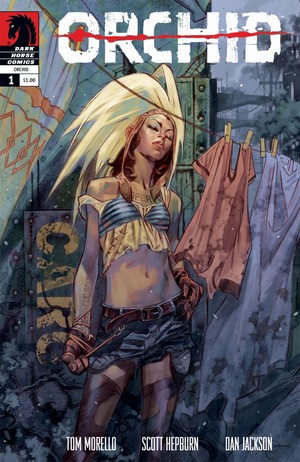 The word ‘Morello’ means a dark cherry of a sour kind used in cooking, and is perhaps a fitting name for Tom Morello. Best known as the lead guitarist of Rage Against the Machine and Audioslave, and for his prominent social activism, Morello has now emerged as the creator of “Orchidâ€, a well-wrought dystopian vision of our near future. It’s so plausible in fact, that you might take it as a warning.
The word ‘Morello’ means a dark cherry of a sour kind used in cooking, and is perhaps a fitting name for Tom Morello. Best known as the lead guitarist of Rage Against the Machine and Audioslave, and for his prominent social activism, Morello has now emerged as the creator of “Orchidâ€, a well-wrought dystopian vision of our near future. It’s so plausible in fact, that you might take it as a warning.
Published by Dark Horse, this tale of rebellion is Morello’s first offering to the world of comic books. The main characters are Orchid, a teenage prostitute, her child brother Yehzu; and Simon, a Shadow Rebel who is on the run with a dangerous relic he must keep safe. The three of them meet under terrible circumstances and are set upon their first arc together in the last few pages of the first issue.
The book begins with images of waves crashing against the chins of Mt. Rushmore, cars swirling around city streets on the ocean floor, and gallons of an oozing green chemical called ‘plasticide’ being dumped by the billions into the sea by a flotilla of tanker ships.
“Great Pacific Trash Vortex Swallows Japan,” reads a newspaper headline.
The agent of this apocalyptic vision is irresponsible environmental policy. Morello has taken the present trajectory of climate change and chemical pollution in the real world, mixed in a bit of science fiction, and pushed the clock forward; how many centuries is unclear.
The changed environment has shifted evolutionary paths: giving rise to huge flowers, strange beasts, gigantic predators and humanoid lizards crawling out of the sea.
Humanity is reduced to meager settlements, filthy shantytowns and fortified mountaintop cities. In “Orchidâ€, civilization has regressed to fiefdom. Tomo Wolfe, the dictator of one such city, Fortress Panuel, has recently crushed a rebellion. The survivors are trapped between Wolfe’s slave traders and THE WILD, “a dense, uncharted wilderness from which ferocious new animal species emerge to prey on the helpless.â€
Scott Hepburn’s (“Star Wars: Knights of the Old Republicâ€) pencil work is a little bit jagged and Dan Jackson’s coloring has a brushy quality to it. The colors are deep and bold, mostly blues, earthy greens and heavy uses of black. Silhouettes often connect one pane to the next, keeping spatial and contextual relationships in view. Almost every page has a red token somewhere within it; a scarf or a tie, a badge or a spurt of blood; always marking something powerful, be it a symbol, a violent act or just a small thing of some importance. All of which perfectly reflects the content of the plot.
When Simon first enters the outpost where he is to meet the title character, there is a good example of Morello’s poetic flare as we read Simon’s thoughts on what he sees there: “Leech addicts dull the day. /The commerce of lust…/The slave traders cull our strongest to toil in the pits of Panuel.â€
The concepts are rich, the copy uncensored and the violence graphically depicted – this book is not for children. And, if the language isn’t too overdone; it will catch on with its intended audience of disgruntled 20-and-30-somethings and the too-smart-not-to-be-frustrated teenagers they once were.
From cover to cover, “Orchid†feels like an extended coming attraction for a movie. It jumps from one sequence to the next, each focused on introducing the main characters and setting up their current circumstances. Despite the squirrely feeling it may give the reader, we get a sense of each character’s personality and the world happening in the background is not distractingly unbelievable. Besides, the pace is to be expected from the first issue of a new title.
“Orchid†grows both out of the hope for and despair of, our fast approaching future. Salty and sweet, bitter and sour; it is a stew of dread, disgust, rage, courage, conviction and optimism – another fine example of Morello’s ability to communicate weighty and urgent ideas through his art.

Leave a Reply